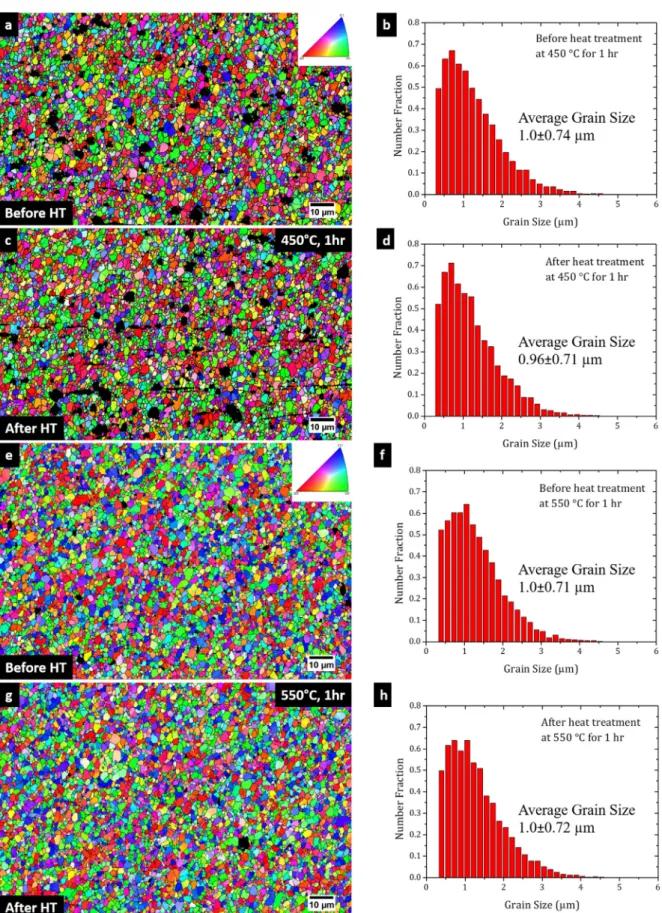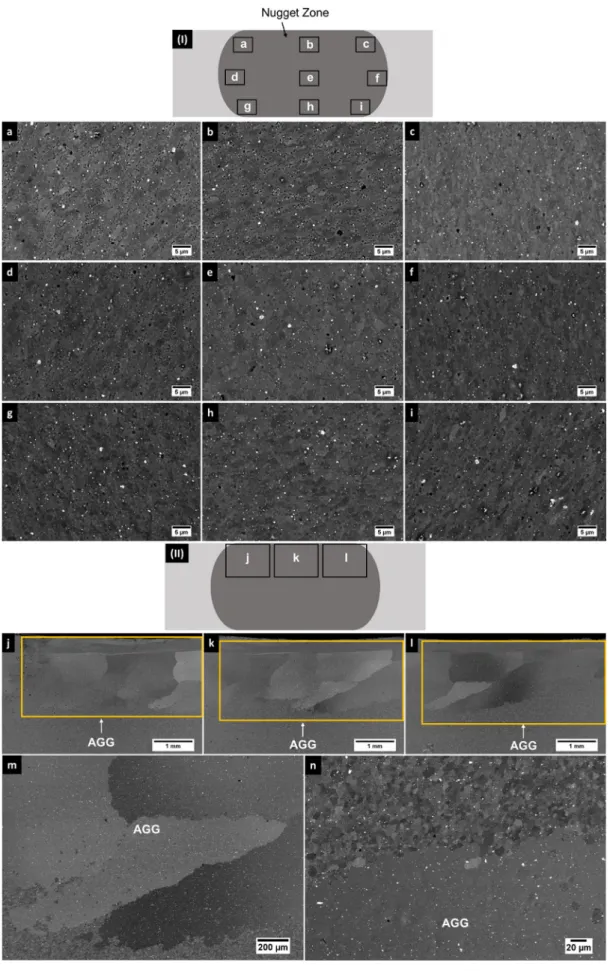Science Arts & Métiers (SAM)
is an open access repository that collects the work of Arts et Métiers Institute of
Technology researchers and makes it freely available over the web where possible.
This is an author-deposited version published in:
https://sam.ensam.eu
Handle ID: .
http://hdl.handle.net/10985/19335
To cite this version :
Abhishek PARIYAR, Laszlo S. TOTH, Satish V. KAILAS, Laurent PELTIER - Imparting
high-temperature grain stability to an Al-Mg alloy - Scripta materialia - Vol. 190, p.141-146 - 2020
Any correspondence concerning this service should be sent to the repository
Imparting
high-temperature
grain
stability
to
an
Al-Mg
alloy
Abhishek
Pariyar
a,b,∗,
Laszlo S.
Toth
b,c,
Satish V.
Kailas
a,
Laurent
Peltier
ca Department of Mechanical Engineering, Indian Institute of Science, Bangalore 560012, India
b Laboratory of Excellence on Design of Alloy Metals for Low-Mass Structure (Labex-DAMAS), Université de Lorraine, 57070 Metz, France c LEM3 Laboratory, Université de Lorraine, CNRS, Arts et Métiers ParisTech, F-570 0 0 Metz, France
a
b
s
t
r
a
c
t
Alalloys,despitetheirexcellentstrength-to-weightratio,cannotbeused atelevatedtemperatures be-causeofmicrostructuralinstabilityowingto graingrowthand precipitate coarsening, thus,leading to adrasticlossintheirstrength.Inthiswork,wehave attemptedtoaddressthe issueofgraingrowth byintroducingin-situformedpolymerderivedceramicsinanAl-Mgalloy.Astablegrainstructurewith minimallossinhardnesswhenexposedto450°Cand550°Cfor1hourwasobtainedduetotheparticle pinningofthegrainboundariesbytheZenermechanism.
Al alloyshavewidespread applicationsin theaerospace, auto-motiveandshippingindustriesbecauseoftheirexcellent strength-to-weight ratiocompared to other alloys [1,2]. However, mostAl alloys cannot sustain their strength at high temperatures,except for a few,like L12 phase forming alloys, which can be used till
343°C [3–6]. One ofthe reasons forthis reduction instrength is duetothe increaseingrain sizewhen exposedto such tempera-tures.
As explained by the Hall-Petch relationship, the strength of a material increases with the decrease in grain size [7,8]. How-ever, there is also an increase in the grain boundary area per unit volume witha decreasein grain size.It hasbeen shownby Humphreys and Hatherley that ifa cube shape is assumed fora grain,reducing thethicknessofa sheetinrollingby50% leadsto an increaseinthesurfacearea ofthe grainby~16%,whereas, re-ducing itby99% increasesthesurfaceareaby ~3267%[9,10]. De-creasingthe grain size leadstoan increase in thefree energy of the system, whichmakes the microstructureunstable. The grains tend to grow in order to minimize this energy by reducing the grainboundaryareaperunitvolume[10].Further,therateofgrain growthalsoincreaseswiththeincreaseintemperature[11].
One way to solve the problemof grain stabilityin aluminum alloys at hightemperatures is by dispersing second phase parti-cleswithintheAlalloymatrix.Suchparticles,whenpresentatthe grain boundaries,apply aretarding/dragforce ontheir movement
whenexposed to hightemperatures.This inhibitsfurther motion ofthegrainboundarieswhichpreventsgraingrowthbythe well-knownZener pinningmechanism. It hasbeen estimatedthat the Zener pinning effect becomesmore pronounced witha decrease in the particle size and increase in their volume fraction [9,11]. However, this mechanism is not active for precipitation harden-ingAl alloys, becausethe precipitatescoarsen ordissolveathigh temperatures.Thiscausesthestrengthtodropdueto recrystalliza-tion,graingrowthandbythereductioninthenumberof disloca-tionbarriers.However,theZenermechanismcanalsobeactivated inboth precipitationhardening andwork hardeningAl alloys, by introducing second phase particles, such as ceramics, which are not partof thealloy system[12,13]. Itis beneficial to use nano-sizedceramicparticlesasreinforcementsbecauseZenerpinningis moreeffectivewiththedecreaseintheparticlesize.However, us-ingsuchparticleshaveissuesrelatedtotheiragglomerationwithin thematrix.In additionto that,they alsoraise themanufacturing costsandare potentiallyhazardoustohealthduringhandlingdue totheir nano-size[14]. Further, thebreaking ofceramic particles belowaparticularsizeisdifficultasthereisareductioninthe de-fectdensitywithadecreaseintheparticlesize, makingthe frac-tureofceramicparticlesprogressivelymoredifficult.
Ceramicscan alsobe obtainedfromspecial typesofpolymers that are readily available. These polymers can be pyrolyzed into ceramic particles. Such polymers contain inorganic elements in their main polymeric chain along with organic components on their branches. Most of the organic components are released as volatiles during pyrolysis and the remaining part forms the amorphous ceramics (called polymer derived ceramics (PDCs))
Table 1
Chemical composition of the as-received Al 5052 alloy.
Element Al Mg Si Cr Mn Fe Cu Zn
Wt.% 96.2 2.81 0.15 0.31 0.10 0.26 0.10 0.06
[15]. Such polymers can be easily broken into nanoscale size, due to their low fracture toughness, by severe plastic deforma-tion methods, especially by high shear processes (e.g. friction stir processing), and can be dispersed within the alloy matrix. Then, by heating to their pyrolysis temperature, the nanosized polymercan be convertedinto nanosizedceramicsin-situ within the alloy. PDCs havevery high temperaturestability as they are ceramics and can potentially pin the grain boundaries even at hightemperatures.Hence,inthiswork,anattempthasbeenmade to impart high temperature grain stability to an Al-Mg alloy by introducingsecondphase particlesintheformofin-situpolymer derivedceramicsusingfrictionstirprocessing. Theparticlesaided in pinning the grain boundaries and maintaining their stability evenat0.85Tm withminimallossinhardness.
The matrixmaterial chosen wasAl 5052-H32 sheet (composi-tionshowninTable1)of6mmthicknesswhichwasannealedat 343°C for2 hrs prior toprocessing. Thepolymer used was poly-methylhydrosiloxane (PMHS) (Sigma-Aldrich) in the liquid state. Theliquidpolymerwasfirstcross-linked atroomtemperaturefor 8hrsintoarigidsolidstructurebyadding5wt.%1,4-diazabicyclo [2.2.2]octane(Sigma-Aldrich).Thecross-linked polymerwasthen subjectedtoball milling for60minutes. Theball-milledpolymer powderwasfilledintogroovesofwidth3mmanddepthof4mm intheAl5052-Oplates.Frictionstirprocessing(FSP)[16]was per-formed on the plates in order to disperse the polymer particles withinthematrixusingahotdiesteeltoolinH13hardened con-ditionhavingaconicalpinwithdoublestartthreads.Thetool pin length was5mm, the diameteratthe base was10 mm,the di-ameterat thetip was 8mm, andthe shoulder diameterwas 25 mmwitha chamferangleof20°.Three back-to-backpasseswere performedinitially at a tilt angle of 2° using 500 RPM tool ro-tationspeed and12 mm/min traverse speed. The plunge depths were5.3mm,5.4mmand5.5mmforthefirst,second andthird passes,respectively.After thethirdpass,thewholeplatewasput forpyrolyzingthepolymerinafurnaceat500°Cfor10hrs. Subse-quently,afourthpasswiththesameexperimentalconditions,but usingaplungedepthof5.6mm,wasperformedinordertoclose theporesformedduetotheemissionofgasesduringthe pyroly-sisofthepolymer.Forthermalstabilitytests, differentspecimens ofthe same material state were subjected to heat treatments at 450°Cand550°Cfor1hourinArgongasenvironment.A temper-atureof 550°C was specially chosen to test the currentmaterial beyondconditions already reported in the literature [10,17]. An-otherspecimenwaspreparedunderidenticalconditionsbut with-outthePDCparticlesandtestedat550°Cfor1hourinArgongas environmentforcomparison.Themicrostructureofeachspecimen wasanalyzedbeforeandaftertheheattreatmentatthesame loca-tionusingelectronbackscattereddiffraction(EBSD)onJEOL6500F. However,theelectropolishingpriortothescanfortheheat-treated specimenremovedafewmicronthicknessresultinginanew sur-face forthe scan. Scanning electron microscope (Zeiss Supra40) andtransmission electronmicroscope(PhilipsCM 200)were also utilizedtoobservethe microstructures.The hardnesstestsbefore andaftertheheattreatmentswereperformedusingaZwick-Roell ZHV1equipment.
Fig. 1 (a) shows the inverse pole figure (IPF) map of the parent material before performing FSP. It can be seen that the grainswere large and nearly equiaxed,typical ofa recrystallized
microstructure.Fig. 1(b)showsthe distributionof thegrain size intheparentmaterial.Itcanbeobservedthatthehighestfraction of thegrains wasbetween 10 to 20μm, andthe maximum size withthelowestfractionwasaround150μm.
Fig. 2 (a) is the IPF map showing the microstructure of the FSP-obtained nuggetzone beforethe heattreatment at450°Cfor 1 hour. As can be seen, FSP produced a fine-grained microstruc-turewithequiaxedgrains.Therewasdrasticgrainrefinement dur-ingtheprocessing.Thehistogramforthegrainsizedistributionis showninFig.2(b);theaveragemeasuredgrainsizewas1.0±0.74 μm(numberfraction-weighted). TheIPFmap oftheexactlysame areaafterheattreatmentisshowninFig.2(c).Themicrostructure lookedverysimilarevenafterheattreatment.Itwasnotidentical to theone before heatingbecauseof theremoval ofa thinlayer beforethe second EBSDmeasurement.The grainsize distribution histogramafterheattreatmentisplottedinFig.2(d).Theaverage grainsize was0.96±0.71μm,whichwassimilarto the non-heat-treated condition. This shows that there wasminimal change in the averagegrain size forthis material,even afterexposing it to suchhightemperature.
Experimentswere conductedatanevenhigherheattreatment temperature.Fig.2(e)istheIPFmapbeforetheheattreatmentat 550°Cfor1hour.ThegrainsizedistributioninFig.2(f)showsthe sameinitialaveragegrainsizeof1.0±0.71μm(samematerialstate asforthelower temperatureheattreatment). The microstructure ofthe specimenafter heat treatmentis shownin Fig.2 (g).It is againobservedthatthe microstructurelookedverysimilar tothe non-heat-treated condition. The average grain size after the heat treatment was 1.0±0.72 μm, which wasthe same as that before theheattreatment.Thegrainsizedistribution(Fig.2(h))wasvery similartothespecimenheat-treatedat450°C.Also,acloser obser-vation ofFig.2(g)showsthat grainswithsimilar orientationdid notcoalesce.Thisresultdemonstratesthelargeresistancetograin growthin thismaterialeven atsuch ahigh temperature(solidus temperatureofAl5052is607°C).
Abnormal grain growth (AGG) is known to occur during the thermaltreatments offrictionstir processedAlalloys[18,19] (es-peciallywhengrainboundarydisorientationsaresmall).Moreover, AGGhasalsobeenobserved inothermaterials thathave suppos-edly a stable grain structure due to particle pinning [20,21]. In suchsituations,someregionsmayexhibitnochangeingrainsize, whereasothersmightshowdrasticgraingrowth.Hence,itwas im-perativetocheckalltheregionsinthenuggetzonetoensurethat suchascenariowasnotprevalent.Figs.3(a-i)showthe backscat-teredelectron (BSE) micrographsobtainedusing a scanning elec-tron microscope(SEM) fromdifferentregions in thenugget zone ofthespecimenwithPDCparticlesheat-treatedat550°Cfor1hr. ThereferenceforthelocationofeachBSEmicrographis schemat-ically represented inFig. 3 (I). It can be observed fromthe SEM micrographs that AGG didnot occur in anyof the examined re-gionswhichprovesthatthemicrostructurewasstablethroughout thewhole nuggetzone,evenat550°C.Figs.3(j-n)show theBSE micrographsafterheattreatmentat550°Cfor1hr,foraspecimen preparedunderidenticalconditionsbutwithoutthePDCparticles.
Fig. 3 (II) is a schematic representation of its nugget zone that serves asareferenceforthelocationsofBSE micrographsshown inFigs.3(j-l).It canbe observedfromthesefiguresthat AGG oc-curredinthisspecimenwhentestedunderthesameconditions.
Fig. 1. (a) IPF map of the parent material. (b) The initial grain size distribution of the parent material.
As mentioned earlier, dispersion of second phase particles in the matrix applies a retardingforce/drag on low and highangle grain boundaries and this has effects on recovery, recrystalliza-tion,andgraingrowth.Thedragpressure(Pz)fromarandom
dis-tribution of particles in the Zener pinning mechanism by which thegrainboundarymotionisinhibitedbyparticlespinningis ex-pressedas[9]:
Pz= 3f
γ
2r (1)
whererandfaretheradiusandvolumefractionofthereinforcing particles,respectivelyand
γ
istheboundaryenergyperunitarea. Zenerpinningisactivewhentheparticlesizeislessthanthegrain size.Themaximumgrainsizelimit(D)untiltheZenerpinningcan beoperationalisgivenby[22]:D= 4r
3f (2)
AnalyzingtheSEMmicrographswiththeImageJsoftware,rand
fwere57nmand0.025,respectively,forwhichthelimitinggrain size Dwascalculatedas3μm.As themeasured grainsizeswere well belowthisvalue,theoperationofthe Zenerpinning mecha-nismisconfirmedinthecurrentspecimen.
In Fig. 4,the TEM bright-fieldimages of the specimenbefore heat treatment (550°C, 1 hr) are shown. It can be observed in
Fig. 4 (a-g) that nanoparticles were distributed throughout the specimen. These nanoparticles did not show any change in the diffraction contrastwithrespect todifferenttilt positions.Such a characteristicisgenerallyexhibitedby amorphousdomains.Since the pre-ceramic PMHS polymer is known to convert into amor-phous SiOC (PDC) after pyrolysis [23], and because PMHS is the only source for such amorphous particles in this system, it can bepresumedthatthosenanoparticleswereSiOCceramicparticles. The nanoscalesize ofthePDCcanbe obtainedasthepreceramic polymer can be easily fractured during FSP before the pyrolysis stage. Hence, the PDC particles can be expected to be in a size rangecomprisingthemicrontothenanoscale(asitisunlikelythat fracturing duringFSP will produce only nanoparticles).At higher magnifications(Fig.4(h)and4(i)),PDCnanoparticlesatthegrain boundaries(markedbyyellowboxes)canbeclearlyobserved.The presenceofsuch nanoparticlescanimpartlargedragforcestothe grain boundaries andhence,impede their motion when exposed tohighertemperatures.
IntheTEMimages(Fig.4(a-g)),sub-micronparticleswerealso observed,albeit farlower innumbercompared tothe nanoparti-cles.Such particlescouldhavebeencontributedfromthe impuri-tiespresentinthematrix,andtheycouldalsobePDCparticles.As mentionedabove the totalparticlevolume fractionwas2.5%, the impurities (Table 1) add up to ~0.5% after conversion to volume percentagesothePDCparticleswerepresentatabout2%volume fraction.Theimpurity-particles hadnorole inthegrain boundary pinning,asitwasobservedintheSEM micrographsinFig.3(j-n) thatAGGoccurredinthespecimenthatdidnotcontainPDC parti-clesdespitehavingsub-micronparticlesdistributedthroughoutthe nugget zone. Hence, it is clear that the reasonfor the specimen toshow grain stabilityat 450°Cand550°C wasdueto the pres-enceofPDCparticles. Part ofthese particles were locatedat the grainboundaries,whiletheremainingpartwaswithinthegrains. EvenifsomeboundariesdidnotcontainPDCparticles,their migra-tioncouldbestoppedby theparticles situatingwithinthegrains. Additionally,itis alsopossible that theamorphous natureof the pyrolyzedPDCparticlesgavesuperiorinterfacialstrengthbetween theparticlesandthematrix.Thiswouldalsoincreasethestrength ofpinningofgrain boundariesbytheparticles.Notealsothat the possible
β
intermetallicphase(Mg5Al8)hadnocontributionatalltoZenerpinningastheMgwasfullyinsolid solutionatthe pro-cessingtemperature(~435°Cto500°C)aswellasduringheat treat-ments(550°Cand450°C).
Grainstabilityupto550°Cwassuccessfullyachieved,however, thestabilityinthemechanicalpropertiesmustalsobeverified.In this regard, micro Vickers hardnesstests were performed before andaftertheheattreatments.Thehardnessbeforetheheat treat-mentwas76±0.764HVandaftertheheattreatmentsat450°Cand 550°C were 74±0.471 HV and 72±0.373 HV, respectively. Hence, fromthe hardnessvalues,it can be inferred that the strength of thematerialchangedveryslightlyevenafterexposuretosuchhigh temperatures.Kumaretal.[10]haveshownthatforafriction stir processed5086Alalloy,thegrainsarestableupto250°Candthe specimenexhibitsAGGwhenexposedto350°Cfor1hr.However, in the same work, it was observed that a friction stir processed andagedtwinrollcastAl-Mg-Scalloyexhibitsconsiderablegrain growthonlywhenexposedto550°Cfor1hr.
In summary,grain stability hasbeen imparted to Al 5052 al-loytill550°CbythepresenceofPDCparticlesusingtheFSP pro-cess. The loss in hardnesswasonly 5.3% after heat treatment at 550°C. Therefore, the material maintained stable microstructure
Fig. 2. (a) IPF map of the specimen before heat treatment at 450 °C for 1 hr. HT stands for heat treatment. The black regions in the IPF map are non-indexed areas where some large particles were present. (b) The grain size distribution before the heat treatment. (c) IPF map of the specimen after the heat treatment. (d) The grain size distribution after the heat treatment. (e) IPF map of the specimen before heat treatment at 550 °C for 1 hr. (f) The grain size distribution before the heat treatment. (g) IPF map of the specimen after the heat treatment. (h) The grain size distribution after the heat treatment.
Fig. 3. (I) Schematic representation of the nugget zone for reference showing the location of each SEM-BSE micrograph of the specimen containing PDC particles heat-treated at 550 °C for 1 hr. The corresponding SEM-BSE micrographs for each region: (a) Top-left (b) Top-central (c) Top-right (d) Middle-left (e) Middle-central (f) Middle-right (g) Bottom-left (h) Bottom-central (i) Bottom-right. (II) Schematic representation of the nugget zone for reference showing the location of each SEM-BSE micrograph of the specimen without PDC particles heat-treated at 550 °C for 1 hr. The corresponding SEM-BSE micrographs for each region: (j) Top-left (k) Top-central (l) Top-right. (m) and (n) SEM-BSE micrographs at higher magnifications showing AGG in the specimen without PDC particles after heat treatment at 550 °C for 1 hr.
Fig. 4. (a-g) Low magnification bright-field images showing the nanoparticles and sub-micron particles. (h) and (i) Bright-field images at higher magnifications showing the nanoparticles at the grain boundary.
and strength during the thermal cycle. The reason for such be-haviorwasdue tograin boundary pinningby the in-situ formed PDCparticles.Since the materialwasfabricated using FSP, verifi-cationforAGGwasalsoperformed,andwasfoundthattherewas noAGGthroughoutthenuggetzonewheretheparticleswere dis-persed.However,aspecimenpreparedunderidenticalconditions, butwithoutthePDCparticles,exhibitedAGGat550°C.
DeclarationofCompetingInterest
Theauthorsdeclarethattheyhavenoknowncompeting finan-cialinterestsorpersonalrelationshipsthatcouldhaveappearedto influencetheworkreportedinthispaper.
Acknowledgements
ThisworkwassupportedbytheFrenchStatethroughthe pro-gram “Investment in the future” operated by the National Re-search Agency (ANR) and referenced by ANR-11-LABX-0008-01 (LabExDAMAS).AbhishekPariyaracknowledges thePh.D. scholar-ship awarded by the Ministry of Human Resource Development, Govt. of India. Also, special thanks to Dr. Yudong Zhang (LEM3, Labex-DAMAS, Metz, France) for the help provided during TEM operation and its data analysis. Thanks also to Dr. Julien Guyon (LEM3,Labex-DAMAS,Metz,France) forthe helpprovided during SEMoperation. A specialappreciation andthanks to Dr. Chandra ShekharPerugu(DepartmentofMaterialsEngineering,IISc Banga-lore,India)fordiscussions.
References
[1] J.G. Kaufman , Introduction to Aluminum Alloys and Tempers, first ed., ASM International, 20 0 0 .
[2] R.D. Bourkhani , A.R. Eivani , H.R. Nateghi , Compos. B Eng. 174 (2019) 107061 .
[3] A.L Kearney , in: ASM Handbook, Properties and Selection: Nonferrous Alloys and Special-purpose Materials, first ed., ASM International, 1990, pp. 152–177 .
[4] L. Ceschini , A. Dahle , M. Gupta , A.E.W. Jarfors , S. Jayalakshmi , A. Morri , F. Rotundo , S. Toschi , R.A. Singh , Aluminum and Magnesium Metal Matrix Nanocomposites, first ed., Springer, Singapore, 2017 .
[5] B. Baradarani , R. Raiszadeh , Mater. Des. 32 (2011) 935–940 .
[6] A.B. Pandey , High Strength L12 Aluminum Alloys, US7909947B2 (2011) .
[7] E.O. Hall , Proc. Phys. Soc. B 64 (1951) 747–753 .
[8] N.J. Petch , J. Iron Steel Inst. 174 (1953) 25–28 .
[9] F.J. Humphreys , M. Hatherly ,Recrystallization and Related Annealing Phenom- ena, second ed., Elsevier, Oxford, 2004 .
[10] N. Kumar , R.S. Mishra , Mater. Charact. 74 (2012) 1–10 .
[11] R. Abbaschian , R.E. Reed-Hill , Physical Metallurgy Principles, fourth ed., Cen- gage Learning, Stamford, 2008 .
[12] F.J. Humphreys , W.S. Miller , M.R. Djazeb , Mater. Sci. Tech.-Lond. 6 (1990) 1157–1166 .
[13] S. Deb , S.K. Panigrahi , M. Weiss , Mater. Charact. 154 (2019) 80–93 .
[14] P. Ajay Kumar , R. Raj , S.V. Kailas , Mater. Des. 85 (2015) 626–634 .
[15] P. Colombo , G. Mera , R. Riedel , G.D. Sorarù, J. Am. Ceram. Soc. 93 (2010) 1805–1837 .
[16] R.S. Mishra , Z.Y. Ma , I. Charit , Mater. Sci. Eng. A 341 (2003) 307–310 .
[17] I. Charit , R.S. Mishra , M.W. Mahoney , Scr. Mater. 47 (2002) 631–636 .
[18] I. Charit , R.S. Mishra , Scr. Mater. 58 (2008) 367–371 .
[19] S. Jana , R.S. Mishra , J.A. Baumann , G. Grant , Mater. Sci. Eng. A 528 (2010) 189–199 .
[20] J.E. May , D. Turnbull , Trans. AIME 212 (1958) 769–781 .
[21] E.A . Holm , T.D. Hoffmann , A .D. Rollett , C.G. Roberts , IOP Conf. Ser.: Mater. Sci. Eng. 89 (2015) 012005 .
[22] P. Bate , Acta Mater. 49 (2001) 1453–1461 .



